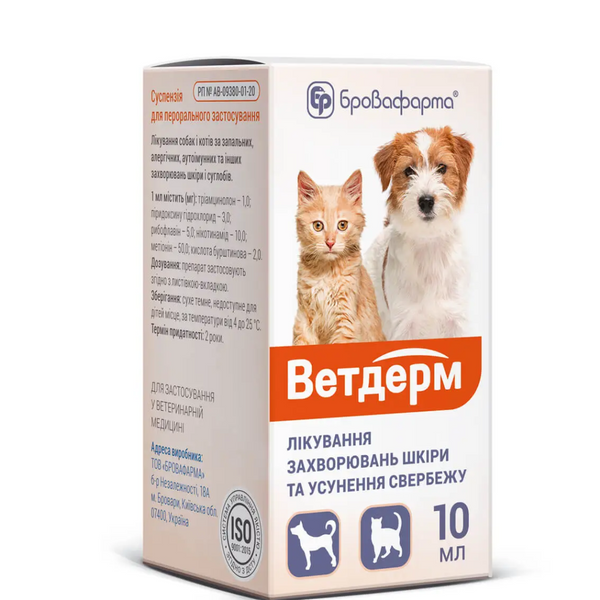|
Quantity
|
Out of stock
|
||
|
|
|||
Description
Light yellow to dark yellow suspension.
Composition
1 ml of the preparation contains active ingredients (mg):
Triamcinolone - 1.0;
Pyridoxine hydrochloride - 3.0;
Riboflavin - 5.0;
Nicotinamide - 10.0;
Methionine - 50.0;
Succinic acid - 2.0;
Excipients: carboxymethylcellulose, tween-80, sodium benzoate, potassium sorbate, xanthan gum, glycerin, aspartame, highly purified water.
Pharmacological properties
ATC-vet classification code: QD07ХВ Moderately active corticosteroids, other combinations. QD07ХВ02 Triamcinolone.
Triamcinolone is a synthetic fluorinated glucocorticoid with pronounced anti-inflammatory, antiallergic, desensitizing and antitoxic effects.
The anti-inflammatory properties of triamcinolone are due to the stabilization of cell membranes, including labrocytes and organelles (lysosomes), inhibition of phospholipase A2 activity, cessation of the release of arachidonic acid from phospholipids of cell membranes and a decrease in the level of its metabolic products. Inhibits hyaluronidase, inhibits the division of labrocytes and reduces their degranulation, inhibits the synthesis of platelet activating factor and connective tissue proliferation. Due to a decrease in the number of T- and B-lymphocytes, disruption of their interaction, and cessation of B-lymphocyte migration, it provides an immunosuppressive and antiallergic effect. Reduces the content of immunoglobulins in the blood serum, inhibits the cooperation of phagocytes and lymphocytes. The anti-shock and antitoxic effect of triamcinolone is based on a decrease in the permeability of the vascular endothelium, membrane-protective properties and activation of liver enzymes,
The bioavailability of triamcinolone after oral administration is 20-30%. The effect appears after 1-2 hours and lasts for 6-8 hours. The half-life of triamcinolone from the blood serum is 2-5 hours, from tissues - 18-36 hours. Triamcinolone is 40% bound to serum proteins, mainly globulins.
Triamcinolone is metabolized in the liver, to a lesser extent - in the kidneys. It is excreted from the body mainly in the urine in the form of inactive metabolites.
Nicotinamide (vitamin PP), riboflavin (vitamin B2) and pyridoxine (vitamin B 6) play an important role in metabolism, participate in cellular oxidation-reduction reactions of amino acids. The use of these vitamins significantly improves the condition of the skin, especially with seborrheic dermatitis and pelagra. Vitamins are easily absorbed in the small intestine and excreted in the urine through various metabolites.
Methionine is an essential amino acid, is a source of sulfhydryl and methyl groups, has a lipotropic effect (prevents the accumulation of fat in the liver with a deficiency of choline, which is involved in the synthesis of phospholipids). By methylation and transsulfuration, methionine neutralizes toxic metabolic products.
Succinic acid accelerates the regeneration processes of damaged skin cells, stimulates and normalizes energy and plastic metabolism, has an antitoxic effect, enhances biochemical and physiological recovery processes in the epidermis and eliminates metabolic acidosis in tissues.
Application
Treatment of dogs and cats with inflammatory, allergic, autoimmune and other diseases of the skin and joints.
Dosage
Vetderm is administered to animals orally once a day, during morning feeding with a small amount of food or administered directly to the root of the tongue using a dosing syringe in doses:
Animal type
Animal body weight (kg)
Daily dose of the drug (per animal, ml)
Dogs
Up to 10
0.5
10-20
1.0
20-30
1.5
30-40
2.0
More than 40
2.0
Cats
1-3
0.25
3 and more
0.5
Shake the bottle with the drug thoroughly before use.
During the first 4 days, the drug is used in the doses given in the table, during the next 8 days, the dose of the drug is reduced by half. If necessary, the treatment period can be extended by agreement with a veterinarian.
Contraindications
Do not use in animals sensitive to the components of the drug.
Do not use simultaneously with other corticosteroid drugs.
Do not use in animals with systemic fungal infections, acute infectious diseases, diabetes.
It is not recommended to use in pregnant and lactating animals, as well as kittens up to 2 months and puppies up to 3 months of age.
It is not recommended to use during the vaccination period, especially with live antiviral vaccines.
Caution
When using the drug in recommended doses, side effects and complications in animals are usually not observed. Rarely, in some animals, with increased individual sensitivity to the components of the drug, vomiting, depression, excessive salivation, and gastrointestinal dysfunction may occur. In these cases, the use of the drug is discontinued.
Production form
Glass or polymer bottles of 10, 15 and 20 ml closed with a rubber stopper under aluminum caps.
Storage
Dry, dark, out of reach
place for children at a temperature of 4 to 25 °C.
Shelf life after first opening (selection) - 28 days.
Shelf life - 2 years.
For use in veterinary medicine!
































